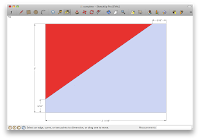Let's take a look at something we all can do.
I had a chance to take a few measurements of a queen anne highboy recently. The cornice was right in this blogs' wheelhouse. (The actual piece had the swan neck molding, but I haven't the time, experience or scrap.)
When working with these larger, deep pieces we will be working off an angled face. Cutting the corner off (in this case at 35 degrees) removes the bulk of the material and leaves only a bunch of small rabbets that can be fired through quickly and efficiently. If you traditionally cut your rabbets with a plow you will be out of luck here. If you cut your rabbets with a moving fillister you will, again, be out of luck. There is no vertical surface to register the fence against, no horizontal to register the depth stop.
If, however, you cut your rabbets with an unfenced rabbet plane and a snipes bill, you are about to cut the easiest eight rabbets yet. Take a look at how to use a these two planes in combination for quick and easy execution.
Note: the depths of the rabbets above are all rounded numbers given by google sketchup. Since we are working with arcs that are all 60 degrees or less (excluding the ovolo on the far left) the bottom of each rabbet is on the arc of the finished profile. Take your time and draw the finished profile on each end, work to that depth.
#6 round
Rabbet followed by #6 hollow
Rabbet followed by #10 hollow
#8 round followed by #16 round. You will actually want to knock off much of the corner of the middle rabbet so the the #16 will be guided by the other two. A 5/8" rabbet is a luxury here. (Love those ellipses.)
Complete
One quick note: I often get asked about rabbet plane width and the limitations that go along with. The above piece is more than two inches wide. The widest rabbet is less than half an inch. A 7/8" or 1" rabbet is not at all limiting. A 5/8" is a nice thing to have when working in tight spaces and the threat of gouging a finished surface with a corner is real. A 5/8" rabbet could take you the whole way here (but I prefer my 7/8".)
















Matt, you're creating a great resource for woodworking here. Thanks for all your detailed contributions.
ReplyDeleteI'm glad to here you're words on plows and free rabbet planes. I use the veritas small plow. A lovely plane but not good for large stock removal. It's good to learn about a few other tricks.